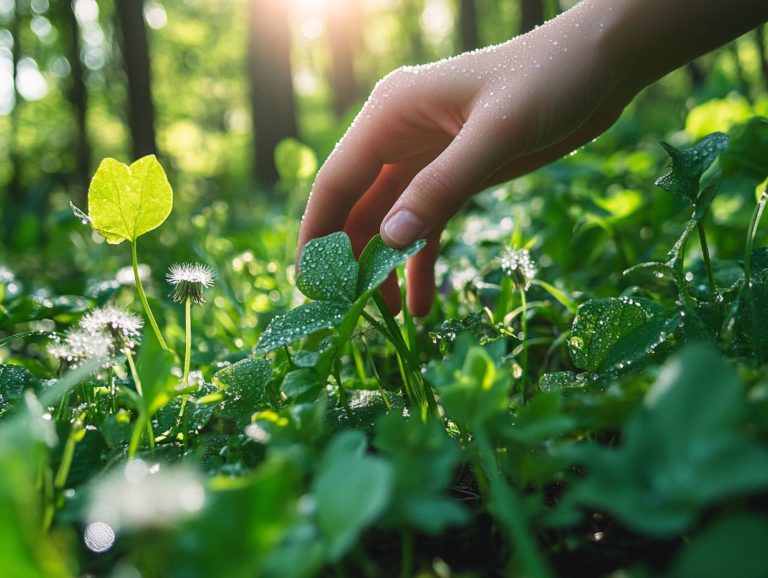5 Essential Tips for Fall Foraging
Foraging in the fall offers a unique opportunity to immerse yourself in nature while gathering exquisite seasonal ingredients. Exploring the diverse offerings of wild food during these autumn days is a truly exciting experience.
Whether you re a seasoned forager or just beginning your journey, knowing what to look for and how to prepare can elevate your experience. This guide provides essential tips to ensure you dress appropriately, equip yourself with the right tools, and prioritize your safety while foraging.
You ll also discover common fall edibles, learn how to identify them, and find valuable tips for preserving your harvest.
Are you ready to explore the exciting treasures autumn has to offer? Let s dive in and discover together!
Contents
- Key Takeaways:
- 1. Know What to Look For
- 2. Dress Appropriately
- 3. Bring the Right Tools
- 4. Know the Rules and Regulations
- 5. Stay Safe and Be Mindful of Your Surroundings
- What Are the Benefits of Foraging in the Fall?
- Frequently Asked Questions
- What is fall foraging and why is it important?
- What are the 5 essential tips for fall foraging?
- How do I identify safe and edible plants and mushrooms for fall foraging?
- Can I forage in any location during the fall season?
- What are some common mistakes to avoid when fall foraging?
- How should I properly store and preserve my foraged finds?
Key Takeaways:
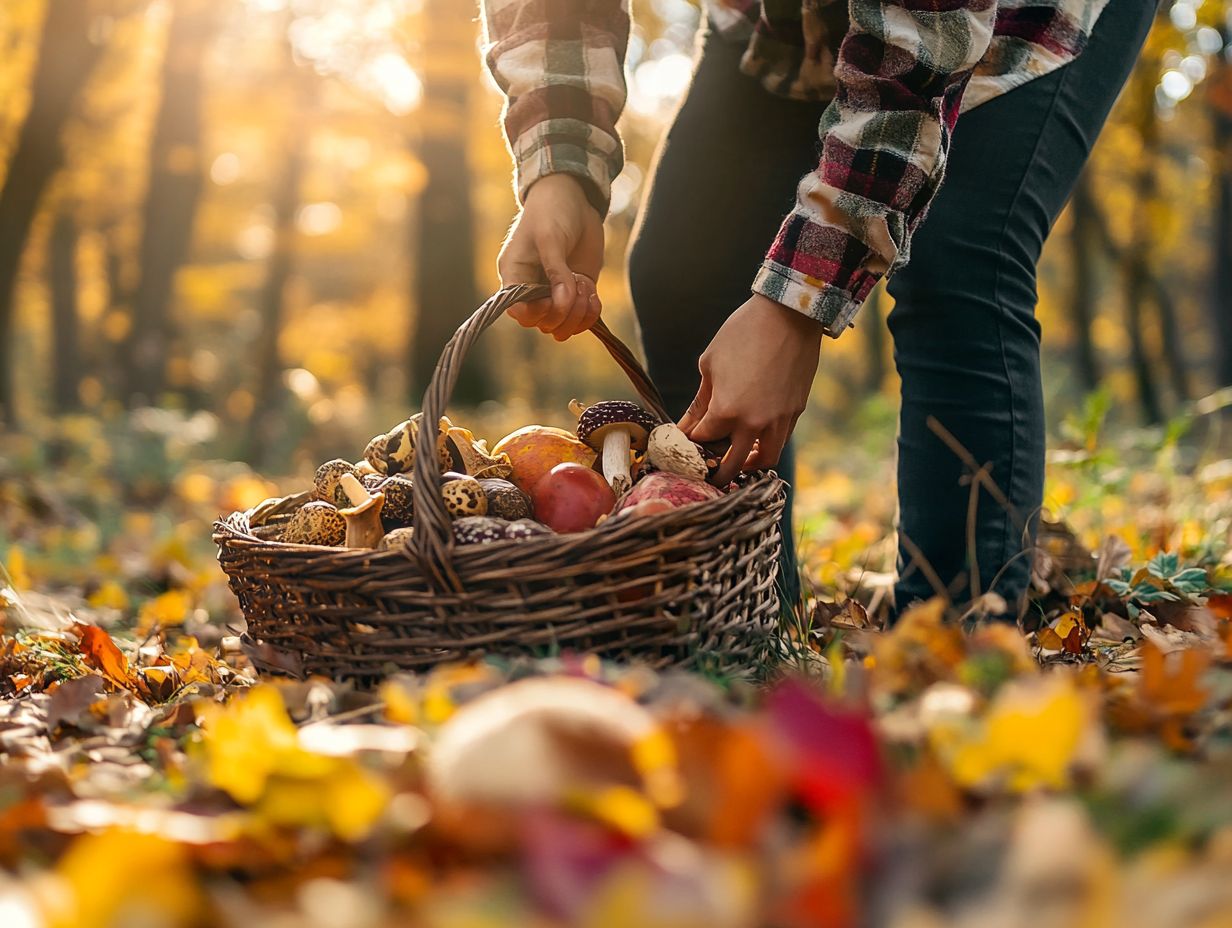
- Know what to look for and identify common edible plants for safe and successful foraging in the fall.
- Dress appropriately and bring the right tools to protect yourself and harvest foraged foods effectively.
- Be aware of rules and regulations to stay safe while foraging for wild fruits and edible plants.
1. Know What to Look For
Understanding what to look for while foraging is crucial for a successful and safe experience. To enhance your skills, consider these top tips for successful foraging, especially during vibrant autumn days when wild food is abundant.
During this season, you can uncover a variety of edible plants. For example, the tart, bright red rose hips develop after blooming and are often found along trails or nestled in thickets. Similarly, black walnuts are easily recognized by their rough, brown shells and distinctive aroma. Don t overlook wild garlic; with its elongated green leaves and robust scent, it thrives in moist, shaded areas, making it a delightful addition to your autumn dishes.
As you embark on this foraging journey, it’s wise to familiarize yourself with local resources and guidebooks that offer quick tips for identifying edible fungi and safe harvesting methods. This knowledge ensures that your adventure into the world of wild foods is both responsible and rewarding.
2. Dress Appropriately
Dressing appropriately for your foraging adventures is essential for comfort and safety as you explore areas brimming with diverse natural features. By choosing the right clothing, you can protect yourself from the elements and potential hazards, allowing you to truly immerse yourself in the beauty of nature.
When venturing into various terrains, opt for breathable, moisture-wicking fabrics to stay cool in warmer weather. Layering is crucial for brisk mornings, and sturdy hiking boots with excellent traction will help you navigate uneven ground safely.
In areas thick with vegetation, wearing long sleeves and pants not only protects you from sun exposure but also serves as a barrier against scrapes and insect bites. Don t forget to bring along a wide-brimmed hat for sun protection and some sunscreen; these simple additions significantly enhance your comfort for longer, more enjoyable outings.
3. Bring the Right Tools
Equipping yourself with the right tools is essential for effective foraging. This not only helps you identify and collect edible plants and mushrooms but also connects you to the vibrant foraging community.
Tools like baskets, knives, and guidebooks greatly enhance your experience. A sturdy field guide serves as your invaluable companion, helping you distinguish between edible species and their toxic counterparts. High-quality mushroom identification tools, such as a spore print kit, add a layer of safety and confidence to your foraging adventures.
Investing in a good pair of tweezers allows you to gently remove mushrooms from their habitat without causing damage. This promotes responsible harvesting. By utilizing these resources, you increase your chances of gathering safe, delicious ingredients while deepening your understanding of local ecosystems.
4. Know the Rules and Regulations
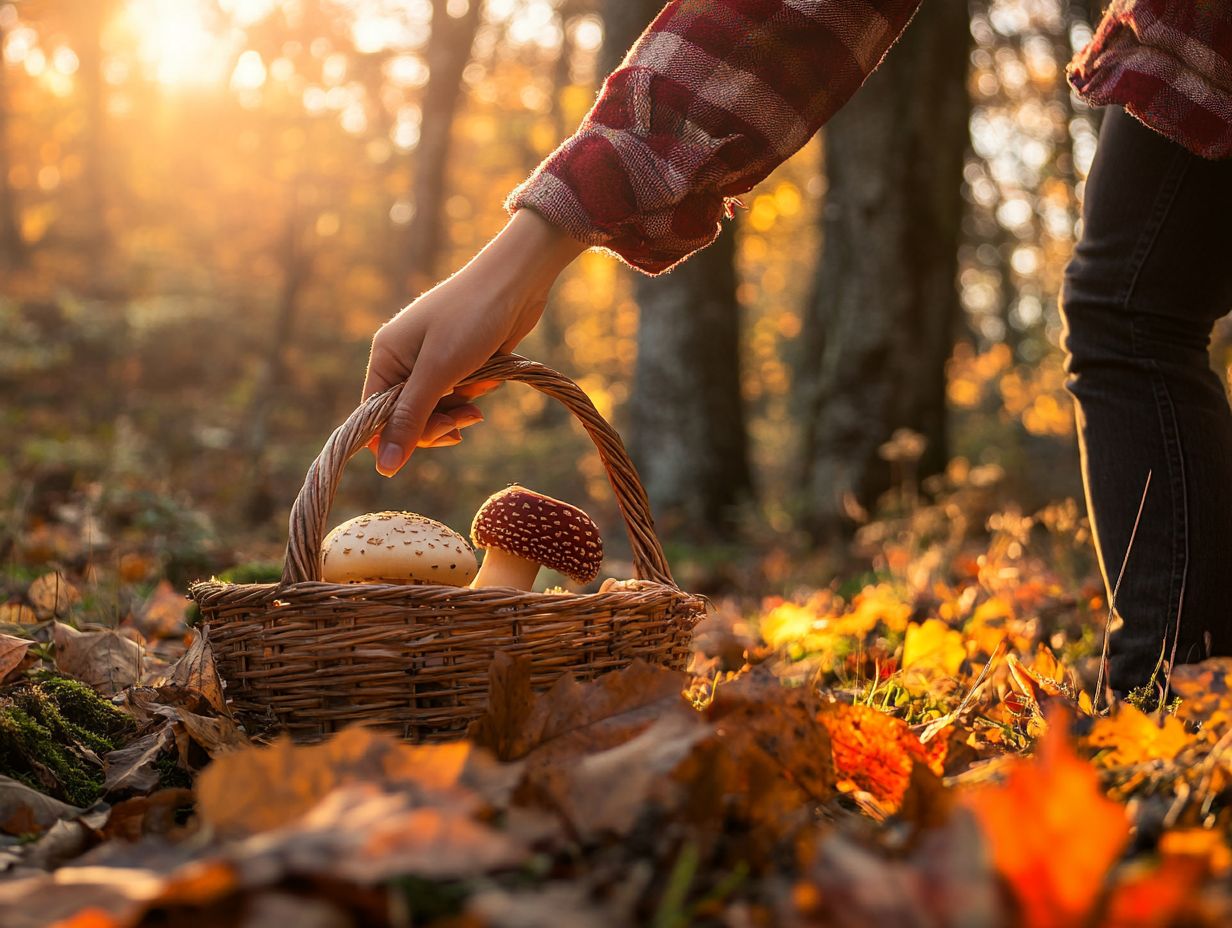
Familiarizing yourself with the rules and regulations surrounding foraging is crucial for safe and responsible practices in your area. This knowledge safeguards the environment and enriches your understanding of the study of how people use plants.
By grasping these guidelines, you can avoid legal pitfalls while foraging for delightful seasonal ingredients like black raspberries and elderberries. Different regions have unique regulations, which may require permits, especially when harvesting in national parks or protected lands.
Some species may be designated as protected, limiting their collection to maintain ecological stability. By respecting natural habitats, you play a vital role in conservation efforts and sustainable food systems, emphasizing the importance of biodiversity.
This mindfulness deepens your connection with nature and promotes responsible harvesting practices that benefit both the environment and local communities.
5. Stay Safe and Be Mindful of Your Surroundings
Understanding your environment is key to a successful foraging experience. Staying safe while foraging requires you to be aware of your surroundings and the potential risks that come with edible and poisonous species.
This mindful approach significantly enhances your foraging experience during those adventurous autumn days. By incorporating safety precautions and essential tips for foraging wild greens into your routine, you can savor the bounty of nature without putting yourself at risk.
One of the most crucial steps is to familiarize yourself with specific poisonous plants, like hemlock water-dropwort. These can easily be mistaken for safe species. You must learn to identify their distinctive features, including growth patterns and preferred habitats.
Pay close attention to your environment; hazardous areas, such as steep hillsides or the vicinity of water bodies, can complicate your journey. Carrying a field guide will help you recognize threats, while maintaining awareness of your footing and surroundings ensures a more enjoyable and safe exploration of nature s treasures.
What Are the Benefits of Foraging in the Fall?
Foraging in the fall offers delightful benefits, including the chance to enjoy food for free. It allows you to connect with the season’s rich tapestry of ingredients, including wild fruits to look for this fall and mushrooms.
This experience enriches your cooking. It also helps you appreciate foraging more. The abundance of flavors and textures available during this time invites you to incorporate foraged foods into your home cooking, crafting unique dishes that celebrate nature’s bounty.
Beyond the thrill of uncovering hidden treasures in the woods, foraging promotes a sustainable lifestyle. It encourages you to source food directly from the environment, reducing reliance on commercial agriculture.
This practice fosters a profound connection with nature, urging you to notice subtle changes in the ecosystem, such as spotting ripe blackberries or gathering edible acorns. Countless foragers have thrilling tales, like finding a patch of chanterelle mushrooms that can elevate a simple risotto with their earthy, gourmet notes.
These successful foraging adventures enhance your cooking skills and instill a sense of accomplishment. You can bring seasonal delights to your table with a sense of pride.
What Are Some Common Fall Edible Plants?
During the fall, a wealth of edible plants becomes ripe for foraging, each offering unique flavors and nutritional benefits to enhance your meals. Think black walnuts, elderberries, wild mint, and staghorn sumac all thriving in various local environments around you. By recognizing these plants, you open your eyes to the diverse variety of nature’s pantry, enriching your culinary repertoire in delightful ways.
Take black walnuts, for instance. You can find them in wooded areas, their distinctive rough exterior and robust aroma hard to miss. They make a fantastic addition to your baked goods and pestos. Elderberries, clustered on shrubs near water sources, deliver a sweet and tangy punch perfect for jams and syrups.
Meanwhile, wild mint s fragrant leaves can elevate everything from teas to sauces. Don t overlook staghorn sumac; its fuzzy red fruit brings a tartness that can brighten up any salad.
Engaging with these seasonal treasures not only nurtures your personal wellness but also supports local ecosystems. Foraging promotes sustainable practices and strengthens community ties through shared experiences. Don t miss out on these seasonal treasures it s a rewarding endeavor well worth your time!
How Can One Properly Identify and Harvest Wild Mushrooms?
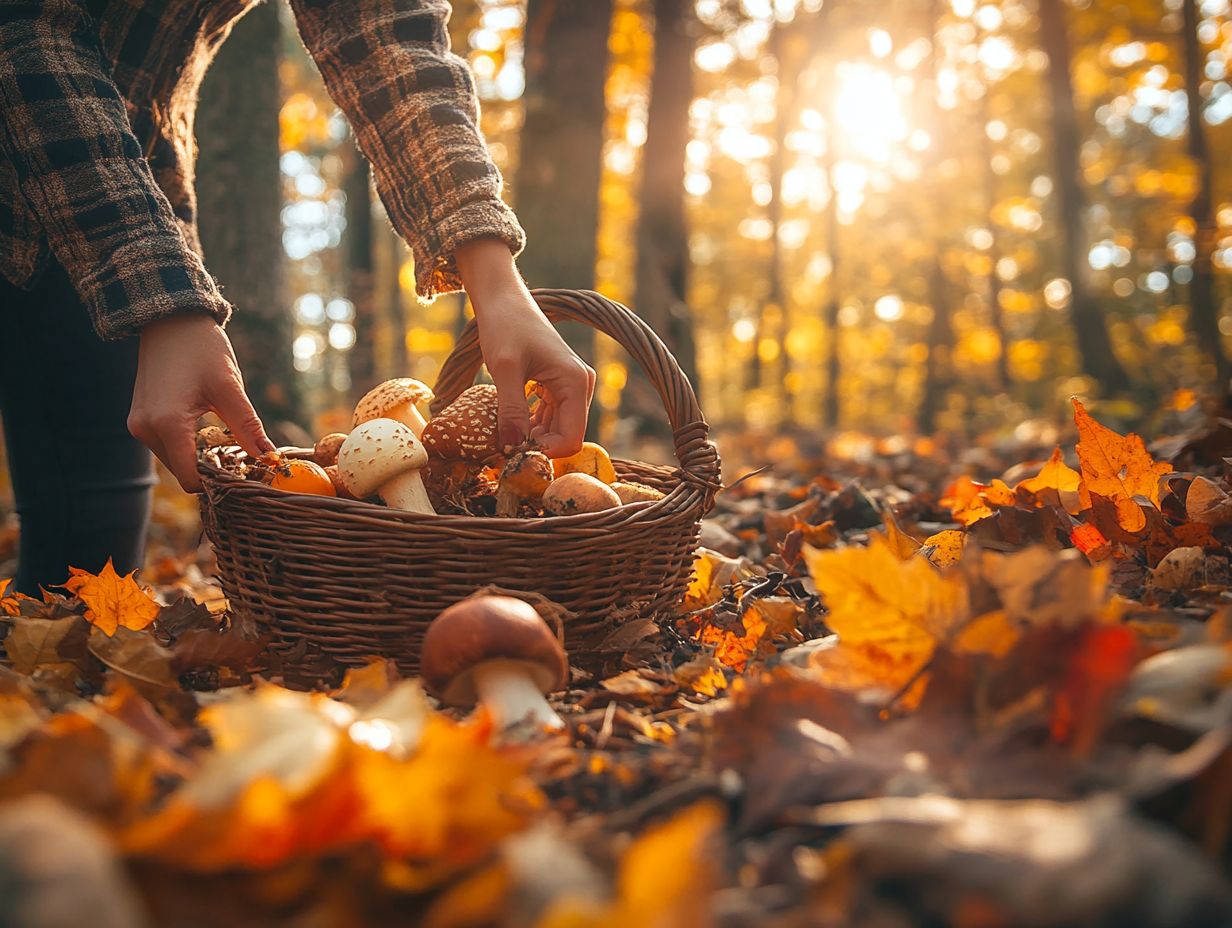
Properly identifying and harvesting wild mushrooms is essential for safe foraging. Many edible varieties, like chanterelles, can easily be mistaken for poisonous species that present serious health risks. By utilizing effective foraging tips and trusted resources, you can embark on a rewarding mushroom foraging adventure filled with delightful discoveries and delectable flavors.
To navigate the mushroom identification process with confidence, focus on examining key characteristics such as gill structure (the part of the mushroom that helps with identification), cap shape, and color variations. For example, the gills of edible mushrooms often reveal significant differences in color and spacing when compared to their toxic counterparts.
Pay close attention to the cap shape whether it s conical, flat, or wavy as this can further assist in accurate identification. Observe subtle hues and patterns for crucial clues.
Regarding safe harvesting techniques, using a sharp knife to cut mushrooms at the base not only preserves their habitat but also ensures sustainability, enriching your foraging experience.
What Are Some Tips for Preserving and Cooking Foraged Foods?
Preserving and cooking with foraged foods can supercharge your culinary adventures, enabling you to savor the distinctive flavors of wild ingredients long after foraging season wraps up. By honing preservation techniques tailored for wild garlic, mushrooms, and other seasonal treasures, you can build an impressive collection of mouthwatering dishes that pay homage to nature s variety.
Consider drying wild garlic; it intensifies its flavor, making it a fantastic addition to your soups and stews during winter. Freezing mushrooms is another brilliant strategy, preserving their texture and taste, especially when exploring cooking with foraged ingredients. This is perfect for adding to risottos or pasta creations later on.
Then there s pickling, which can turn seasonal vegetables into zesty delights, ideal for jazzing up salads or serving as appetizers.
Experimenting with these methods not only preserves the character of your foraged finds but also sparks creativity in your kitchen. By embracing these techniques, you can elevate your meals and craft unforgettable experiences that truly showcase the essence of foraged fare.
What Are Some Common Mistakes to Avoid When Foraging in the Fall?
Foraging in the fall can be an exciting adventure. However, certain common mistakes can diminish your success and compromise your safety, such as misidentifying species like Poison Hemlock or overlooking poisonous plants such as Black Walnuts. By understanding these challenges and adopting essential safety precautions, you can elevate your foraging skills. Consider exploring the top foraging techniques for beginners to fully savor the seasonal bounty with confidence.
One of the most critical missteps is failing to thoroughly research local species before setting out. Each region boasts unique varieties, some of which can look strikingly similar, increasing the risk of mix-ups.
Neglecting to consult seasonal guides can lead to missed opportunities for prime foraging. To mitigate these risks, prioritize studying field guides, joining local foraging groups, or attending workshops where experts share 7 essential foraging skills for everyone that provide invaluable insights.
By taking these proactive steps, you ll boost your confidence and ensure that your foraging outings are safer and more rewarding.
How Can Foraging Help Connect People with Nature?
Foraging serves as a powerful bridge connecting you with nature, deepening your appreciation for local ecosystems and food systems. It opens doors to engage with the vibrant foraging community. This connection enhances your understanding of the study of how people use plants and the important role that wild plants and fungi like chanterelles play in our lives and cultures.
As you embark on the journey of foraging, you ll discover the art of identifying various plants and mushrooms, along with their uses and benefits. This hands-on experience enriches your knowledge and sparks conversations within local communities, where workshops, local foraging groups, and foraging events thrive. You ll bond with fellow enthusiasts, exchanging recipes and tips that nourish a culture of environmental stewardship.
These experiences cultivate a profound respect for nature and underscore the importance of sustainable harvesting practices, ensuring these valuable resources remain available for future generations.
Frequently Asked Questions
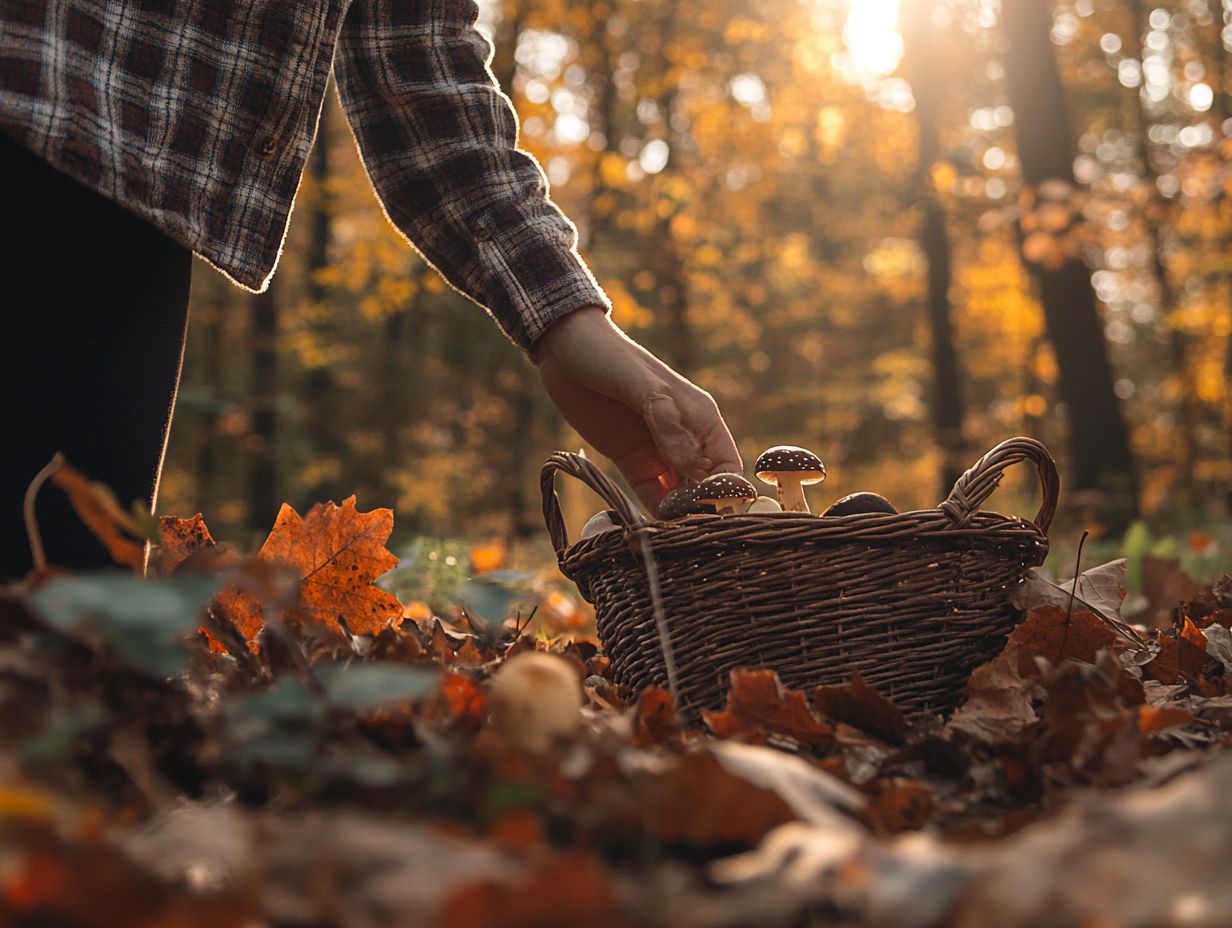
What is fall foraging and why is it important?
Fall foraging is gathering wild edibles in autumn. It’s crucial as many plants and mushrooms peak in flavor and nutrition during this time, so be sure to follow the dos and don’ts of foraging.
What are the 5 essential tips for fall foraging?
- Know your plants and mushrooms, particularly your foraging favorites.
- Be aware of seasonal changes.
- Dress for the weather.
- Bring the right tools, such as a sharp knife.
- Respect nature and its inhabitants.
How do I identify safe and edible plants and mushrooms for fall foraging?
It is crucial to properly identify plants and mushrooms before consuming them. Use a reliable field guide and cross-reference with multiple sources. When in doubt, do not eat it.
Can I forage in any location during the fall season?
It is important to know the laws and regulations of the area you plan to forage in, especially in regions like West Michigan. Some locations may have restrictions or require permits for foraging. Always respect private property and do not forage in protected or endangered areas.
What are some common mistakes to avoid when fall foraging?
Avoid picking plants and mushrooms near roadsides or polluted areas. Also, do not over-harvest from one location, as it can harm the ecosystem. Lastly, never eat anything that you are not 100% certain is safe and edible.
How should I properly store and preserve my foraged finds?
Foraged plants and mushrooms should be stored in a cool, dry place and consumed within a few days to enjoy the freshest autumn harvests. Mushrooms can also be dried or pickled for longer preservation. Always clean and inspect thoroughly before consuming.
Embrace fall foraging and connect with nature today!

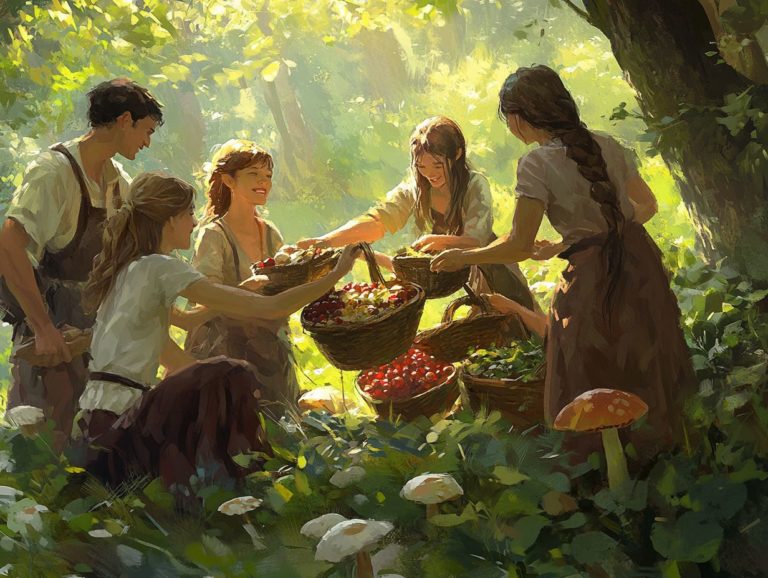
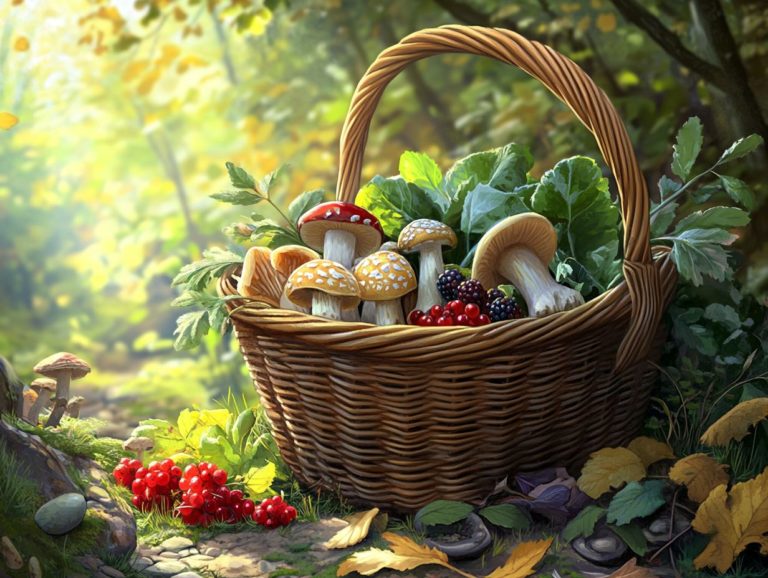
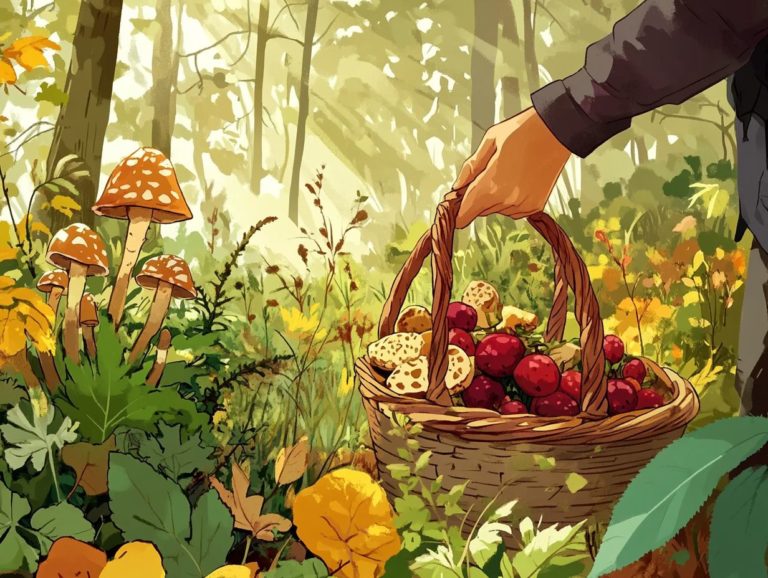
![What to Know About Seasonal Foraging in [Your Area]](https://forageadept.com/wp-content/uploads/2024/08/what-to-know-about-seasonal-foraging-in-your-area-HB-768x578.jpeg)
![Top Local Edibles to Forage in [Your Area]](https://forageadept.com/wp-content/uploads/2024/08/top-local-edibles-to-forage-in-your-area-1X-768x578.jpeg)
